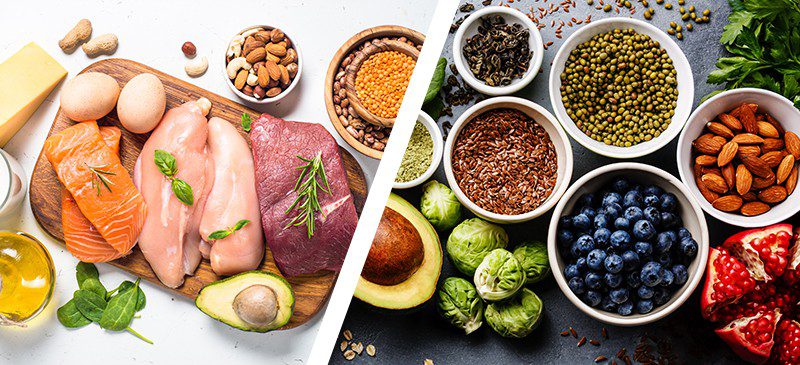Originally designed to control inflammation by switching up your meal plan, the Zone Diet is a popular fad diet that claims to help slow aging, reverse disease and bump up fat-burning.
Like similar weight loss regimens, it involves changing the macronutrient composition of your diet and prioritizing nutritious, minimally processed ingredients like fruits, veggies, lean proteins, and healthy fats.
According to the creator of the diet, this can alter your hormone levels and put you in “the Zone,” a physiological state that allows you to reap the full benefits of the diet.
This article takes a closer look at the pros and cons of the Zone Diet, how to follow it, and whether or not it’s a good option for improving your health.
What Is the Zone Diet?
The Zone Diet is a popular eating plan that was developed by Dr. Barry Sears, an American biochemist and author of “The Zone: A Dietary Road Map,” which was released in 1995.
Proponents of the diet claim that it can help reduce inflammation, which in turn could help boost weight loss, slow signs of aging, and aid in the prevention of chronic disease.
The diet involves tracking your macronutrient intake and sticking to a ratio of around 40 percent carbohydrates, 30 percent protein, and 30 percent fat.
Ideally, your diet should be composed mostly of lean proteins, monounsaturated fats and fruits, vegetables, and whole grains with low glycemic indexes.
Keep in mind that the Zone Diet is not related to the keto zone diet or blue zone diet, both of which are other eating patterns aimed at increasing weight loss, enhancing longevity, and improving overall health.
How Do You Follow It?
A typical Zone Diet meal plan should be composed of about 40 percent carbohydrates, 30 percent protein, and 30 percent fat.
There are two main methods that you can use to estimate your macronutrient intake, including the hand-eye method and the block method.
The hand-eye method is the most straightforward strategy for tracking your Zone Diet macros, which involves dividing your plate into thirds.
One-third of your plate should be filled with lean protein foods, such as egg whites, low-fat dairy, or skinless poultry, and two-thirds should be composed of carbs with low glycemic indexes, including fruits, veggies or whole grains.
A small amount of healthy, monounsaturated fats should also be included, such as olive oil, avocados, nuts, or seeds.
Besides paying close attention to what you put on your plate, it’s important to monitor when you eat as well.
With the hand-eye method, your five fingers are used to remind you to eat five times per day and never go more than five hours at a time without eating.
In addition to being very simple, the hand-eye method is also flexible and can be a good option when dining out.
Another popular method involves tracking Zone Diet blocks, which are calculated based on your specific macronutrient needs.
On the diet’s official website, it offers a free Zone Diet calculator, which requires you to input your height, weight, body measurements, and activity level.
It then provides guidelines for the number of protein, carbohydrate, and fat blocks that you should aim for each day.
Generally, most women should consume around 11 blocks per day, while men should aim for approximately 14 blocks on average. Meals should contain between three to five blocks, and snacks should contain one block, which should be composed of protein, fats, and carbs in a 1:1:1 ratio.
Here are the amounts of each macronutrient present in a block:
- Protein: 7 grams of protein per block
- Fat: 1.5 grams of fat per block
- Carbohydrates: 9 grams of carbs per block
Although this method can be a bit confusing at first, there are many Zone Diet blocks spreadsheet tools and calculators available online to help make it more manageable.
What Can You Eat?
The Zone Diet encourages plenty of lean proteins, low-glycemic carbohydrates, and heart-healthy fats. Here are a few of the specific foods that can be enjoyed as part of the diet plan:
Protein
- Skinless poultry: chicken, turkey, goose, duck
- Lean cuts of meat: beef, lamb, veal, pork
- Seafood: fish and shellfish
- Low-fat dairy products: milk, yogurt, cheese
- Soy products: tofu, tempeh, miso, natto
- Egg whites
Carbohydrates
- Fruits: strawberries, apples, blackberries, blueberries, melon, oranges, nectarines, plums, peaches, apricots
- Vegetables: asparagus, cucumbers, celery, radishes, carrots, tomatoes, cauliflower, broccoli, spinach, kale
- Whole grains: quinoa, couscous, barley, buckwheat, oats
Fat
- Nuts: almonds, walnuts, pistachios, pecans, macadamia nuts
- Nut butter: peanut butter, almond butter, cashew butter
- Seeds: flax seeds, sesame seeds, pumpkin seeds
- Vegetable oils: extra-virgin olive oil, sesame oil, peanut oil
- Avocados
Wondering what a typical Zone Diet breakfast, lunch, or dinner might look like? Here are some sample meal ideas that you can adjust to fit your needs, along with some simple Zone Diet recipes:
Breakfast:
- Egg white omelet with veggies, olive oil, and fruit cup
- Oatmeal topped with berries and almonds.
- Greek yogurt with pumpkin seeds and strawberries
Lunch:
- Roasted turkey with sautéed kale, sesame oil, and fruit cup
- Beef and Quinoa Stuffed Bell Peppers with mixed veggies and olive oil
- Burrito bowl with rice, chicken, avocado, bell peppers and tomatoes
Afternoon Snack:
- Cottage cheese with sliced plums and walnuts
- Salad with hard-boiled egg and salad dressing
- Tuna with crackers and avocado
Dinner:
- Blackened Salmon with Creamy Avocado Dressing with herbed couscous and steamed broccoli
- Grilled chicken with a side salad, olive oil dressing, and sweet potato wedges
- Marinated tempeh with asparagus, sliced avocado, and wild rice
Evening Snack:
- Hard-boiled egg with whole-wheat toast and peanut butter
- String cheese with mandarin orange and avocado
- Smoothie with protein powder, berries, and almond butter
Foods You Can’t Eat
Although no foods are completely off-limits, the Zone Diet recommends restricting foods that are not included in the anti-inflammatory diet pyramid, including many high-sugar fruits, soft drinks, and processed foods.
Here are a few other foods that you may want to avoid on the Zone Diet:
- High-sugar fruits: bananas, grapes, mangoes, pineapple, dried fruit
- Starchy vegetables: potatoes, corn, carrots, peas
- Refined carbs: white bread, pasta, tortillas, bagels, chips
- Processed foods: frozen meals, fast food, cookies, baked goods, pretzels, fried foods
- Sugary drinks: sweet tea, soda, juice, sports drinks
Caffeinated beverages like coffee and tea should also be limited and swapped for water whenever possible.
How Does It Work?
According to the creator of the diet, following this simple eating pattern can alter your hormone levels and allow you to enter “the Zone,” a physiological state that helps reduce levels of inflammation throughout the body.
In addition to ramping up weight loss, maintaining this physiological state can also optimize cognitive health, slow signs of aging, and boost the body’s natural fat-burning abilities.
To determine whether or not you’re in “the Zone,” Dr. Barry recommends testing your levels of three clinical markers, including:
- Triglyceride (TG)/high-density lipoprotein (HDL) cholesterol ratio
- Arachidonic acid (AA)/eicosapentaenoic acid (EPA) ratio
- Hemoglobin A1C
If these three levels are within range, the body is said to be in “the Zone,” meaning that you can reap the full rewards of the diet.
Health Benefits
The Zone Diet encourages a wide range of healthy foods and doesn’t set strict limitations on which ingredients should be restricted or avoided. For this reason, it may be a good option for dieters seeking flexibility and variety.
It is also very similar to the Mediterranean diet, an eating plan rich in fruits, vegetables, nuts, seeds, and whole grains.
Studies show that the Mediterranean diet could protect against several chronic health conditions, including heart disease, cancer, diabetes, and neurodegenerative disorders like Alzheimer’s disease.
Although more research is needed, adopting a similar diet pattern — such as the Zone Diet — could offer the same set of health benefits.
Because the diet encourages low-glycemic, minimally processed ingredients, it could also improve the quality of your overall food.
Studies suggest that following a low-glycemic diet could potentially help promote blood sugar control and enhance the body’s ability to use insulin efficiently.
What’s more, other research has found that eating fewer processed foods could be linked to a lower risk of weight gain.
Many also associate the Zone Diet with CrossFit, a fitness regimen focused on high-intensity interval training.
Because it’s relatively high in protein, the Zone Diet may help support tissue repair and enhance muscle growth to give your workout a boost.
However, research on the effects of the diet on athletic performance has turned up mixed results. Therefore, more studies are needed to determine how the Zone Diet may impact exercise.
Risks, Side Effects, and Downsides
Although the Zone Diet could come with some potential benefits, there are some downsides to consider as well. For starters, there is little to no research to support the basis of the diet.
According to a review published in the Journal of the American College of Nutrition, “a review of the literature suggests that there are scientific contradictions in the Zone Diet hypothesis that cast unquestionable doubt on its potential efficacy.”
Some may also find the diet difficult to follow in the long run.
The block method, in particular, may require precise tracking and measuring of foods to maintain the macronutrient ratio recommended by the diet.
The hand-eye method can be a good alternative for those seeking a more straightforward approach, but it may not be entirely as accurate.
Furthermore, some studies show that the Zone Diet may not be an excellent choice for everyone when it comes to athletic performance.
In one study, athletes following the diet for one week experienced a significant decline in endurance and became exhausted much more quickly.
According to the authors of the study, “this is not a nutritional strategy that athletes should use until further work has been conducted.”
Conclusion
- What is the Zone Diet? The Zone Diet is a popular eating plan aimed at reducing inflammation and improving overall health.
- Despite having a similar name, the Zone Diet is not related to the blue zone diet or keto zone diet, both of which are other eating plans aimed at enhancing health.
- The Zone Diet is composed of about 40 percent carbohydrates, 30 percent protein and 30 percent fat, which can be measured using the hand-eye or block method.
- Although no foods are strictly off-limits on a diet, a typical meal plan should include mostly lean proteins, low-glycemic carbohydrates, and monounsaturated fats.
- In addition to being highly flexible, the diet encourages a variety of healthy foods and is similar to the Mediterranean diet, which has been shown to protect against disease. Other potential Zone Diet benefits maybe because it encourages increased protein intake and low-glycemic foods.
- On the other hand, there is little evidence to support the basis of the Zone Diet. It may also be challenging to follow in the long run and may not be the right choice for athletes.
- Therefore, while the Zone Diet may be an excellent tool to start building healthy habits, eating a variety of healthy, minimally processed foods can be just as useful for promoting long-term health.








